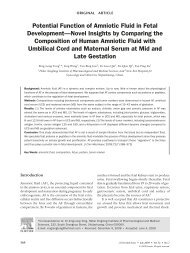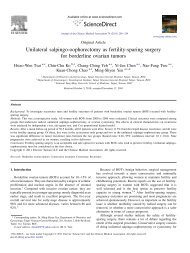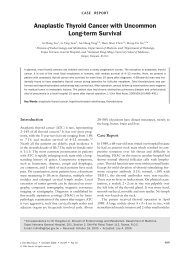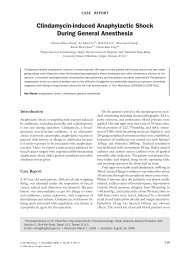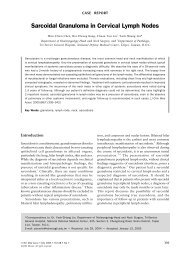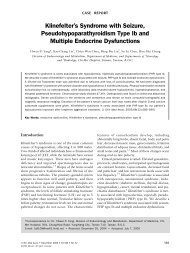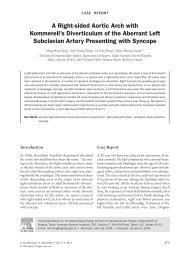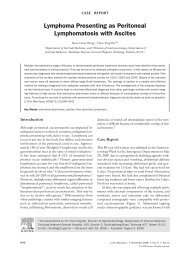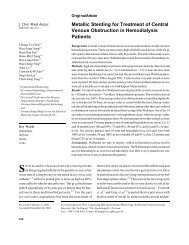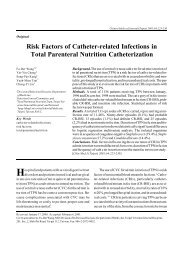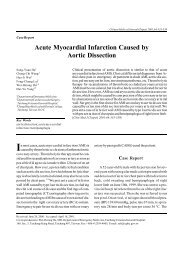Surgical Anatomy of Supratentorial Midline Lesions
Surgical Anatomy of Supratentorial Midline Lesions
Surgical Anatomy of Supratentorial Midline Lesions
You also want an ePaper? Increase the reach of your titles
YUMPU automatically turns print PDFs into web optimized ePapers that Google loves.
The pericallosal artery was found to give rise to four types <strong>of</strong> branches that supply the corpus callosum: 1) the callosal artery, 2) the<br />
cingulocallosal artery, 3) the long callosal artery, and 4) the recurrent cingulocallosal artery. The callosal arteries, thin branches arising from the<br />
pericallosal artery, directly supplied the inclusium griseum and the superficial surface <strong>of</strong> the corpus callosum in the midline. They were present<br />
in 50% <strong>of</strong> the hemispheres and did not branch into the callosal sulcus. Their numbers varied between 0 and 3 (average, 0.7) per hemisphere, and<br />
their diameters ranged between 0.15 and 0.3 mm (average, 0.2 mm)(Figs. 5A and 11 and Table 2).<br />
TABLE 2. Characteristics <strong>of</strong> Branches from the Pericallosal Artery That Supply the Corpus Callosum<br />
The cingulocallosal artery played the most important role in the blood supply <strong>of</strong> the corpus callosum. It arose from the inferolateral aspect<br />
<strong>of</strong> the pericallosal artery and ran laterally into the callosal sulcus, where it divided into three arterial subgroups, one <strong>of</strong> which supplied the<br />
corpus callosum. The second, arranged in a brush-like formation, supplied the cingulate gyrus; the third followed the depths <strong>of</strong> the callosal<br />
sulcus and coursed laterally to supply the radiation <strong>of</strong> the corpus callosum. The cingulocallosal arteries anastomosed with each other and with<br />
branches arising from the subcallosal, median callosal, and long callosal arteries to form the pericallosal pial plexus. This plexus was most<br />
developed in the region <strong>of</strong> the splenium, where it received a further contribution from the posterior pericallosal artery, a feature that was<br />
observed in all hemispheres. The cingulocallosal arteries ranged in number from 3 to 23 per hemisphere(average, 9). Their diameters ranged<br />
between 0.15 and 0.6 mm (average, 0.25 mm) (Figs. 5B, 6, and 11 and Table 2).<br />
FIGURE 6. Branches from the pericallosal artery to the corpus callosum (2), the radiation <strong>of</strong> the corpus callosum (4), and the cingulate<br />
gyrus(1) in coronal view. The cingulocallosal artery( thin arrow) arises from the pericallosal artery and courses within the callosal sulcus where<br />
it gives branches to the corpus callosum (inferiorly), the radiation <strong>of</strong> corpus callosum (laterally), and the cingulate gyrus (superiorly). The long<br />
callosal artery (thick arrow) arises from the pericallosal artery, courses parallel to it in the callosal sulcus, and has callosal and cingulocallosal<br />
branches.3, fornix.<br />
The long callosal artery, another branch arising from the pericallosal artery, coursed parallel with it in the callosal sulcus and had multiple<br />
branches that contributed to the pericallosal pial plexus. It was present in 55% <strong>of</strong> the hemispheres studied. The number ranged from 0 to 3 per<br />
hemisphere(average, 0.62), and the diameters ranged between 0.2 and 0.9 mm (average, 0.45 mm). The artery terminated in the body <strong>of</strong> the<br />
corpus callosum (24%) or in the medial longitudinal striae at the splenium (16%). The remainder either anastomosed with the posterior<br />
pericallosal artery <strong>of</strong> the same hemisphere(48%) or crossed the midline and anastomosed with the posterior pericallosal artery <strong>of</strong> the opposite<br />
hemisphere (12%), both within the callosal sulcus in the splenial region (Figs. 5C, 6, and 11 and Table 2).<br />
The recurrent cingulocallosal artery, a thin branch, arose from major cortical branches <strong>of</strong> the pericallosal artery: the superior internal<br />
parietal artery (40%), the paracentral artery (20%), the callosomarginal artery (16%), the anterior internal frontal artery (10%), the inferior<br />
internal frontal artery (10%), or the frontopolar artery (4%). It coursed on the medial surface <strong>of</strong> the cingulate gyrus toward the callosal sulcus,<br />
was present in 45% <strong>of</strong> the hemispheres, and contributed to the pericallosal pial plexus. The recurrent cingulocallosal arteries ranged in number



